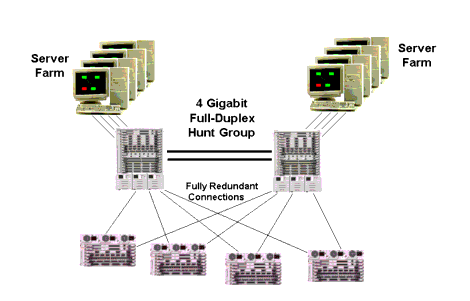|
|
|
Hunt groups make it possible for you to aggregate multiple switch ports to act as one switch port, effectively combining the bandwidth into a single connection. Frames sent to the hunt group will be transmitted by one of the ports in the hunt group. Hunt groups load share traffic across all member ports, this aggregates the bandwidth of the hunt group ports. Hunt groups also provide fault tolerance. If a port in a hunt group fails, the remaining ports in the hunt group will assume the traffic and continue forwarding. Figure�47 shows an example of a hunt group.

Hunt groups expand the capacity of the core switched backbone. While there is no specific limit on the number of ports in a hunt group (see "Hunt Group Configuration Considerations"). In the example, the hunt group consists of two full-duplex Gigabit Ethernet links shared between two switches, for an aggregate capacity of 4 Gbps. Enterprise-level servers can be directly attached to the switching core using either 100 Mbps or Gigabit Ethernet connections. Fault-tolerant spanning tree links from the core to the next level of network spread the distribution and capacity to building or departmental switching centers. Each of these next-level switches may in turn support tens (or even hundreds) of work group switches and users.
This section contains the following information and procedures:
|
|
|